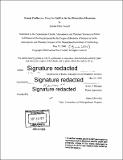Stream profiles as a proxy for uplift in the San Bernardino Mountains
Author(s)
Cornell, Katrina Muir
DownloadFull printable version (4.862Mb)
Other Contributors
Massachusetts Institute of Technology. Department of Earth, Atmospheric, and Planetary Sciences.
Advisor
Kelin X Whipple.
Terms of use
Metadata
Show full item recordAbstract
Stream profile analysis provides new insight into the tectonic history of the San Bernardino Mountains of Southern California. The San Bernardino Mountains, along with the nearby San Gabriel Mountains, have been tectonically uplifted since the late Miocene due to transpression-related thrust faulting. Although regional uplift patterns are not as clear from this data as those of a stream profile analysis in the San Gabriel Mountains, the results observed indicate that this technique can extract useful tectonic data and provide a fast, inexpensive, and easy way to focus fieldwork in a region. For example, in the San Bernardino Mountains, stream profile interpretation from digital elevation models (DEMs) indicates the current/most recent uplift rates on the Yucaipa Ridge at the southern range front are only ~0.5-0.6 mm/yr, much lower than indicated by a published (U-Th)/He age-elevation transect. Also, a change in steepness index (ksn) values between the north and south sides of the Santa Ana Thrust Fault suggests differential uplift across it as recently as the mid to late Quaternary. However, there are important limitations to the method that render interpretations non-unique. For example, the channel downstream of the dam at Big Bear Lake is much steeper than adjacent streams; a tectonic explanation is unlikely. One possibility is that large landslide- and debris-flow-derived boulders have armored the channel and caused the river to oversteepen.
Description
Thesis: S.B., Massachusetts Institute of Technology, Department of Earth, Atmospheric, and Planetary Sciences, 2006. Cataloged from PDF version of thesis. Includes bibliographical references (pages 30-32).
Date issued
2006Department
Massachusetts Institute of Technology. Department of Earth, Atmospheric, and Planetary SciencesPublisher
Massachusetts Institute of Technology
Keywords
Earth, Atmospheric, and Planetary Sciences.